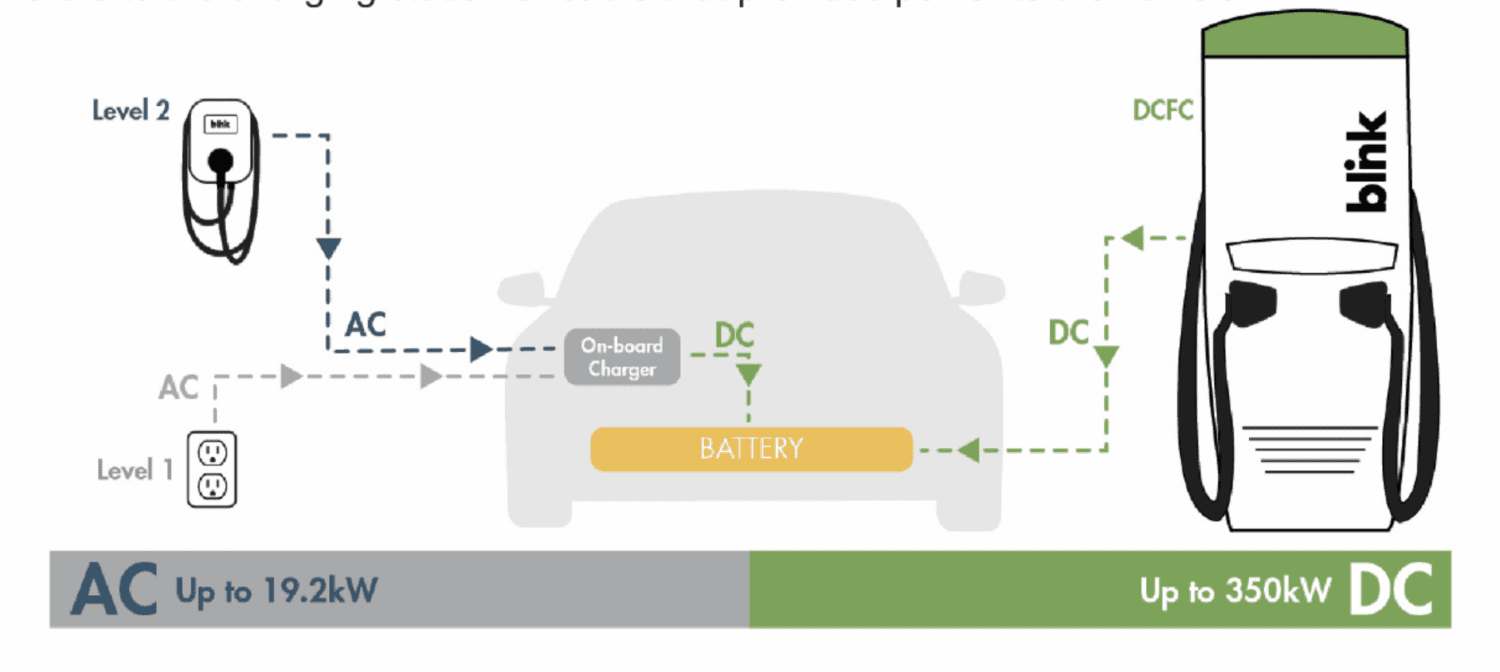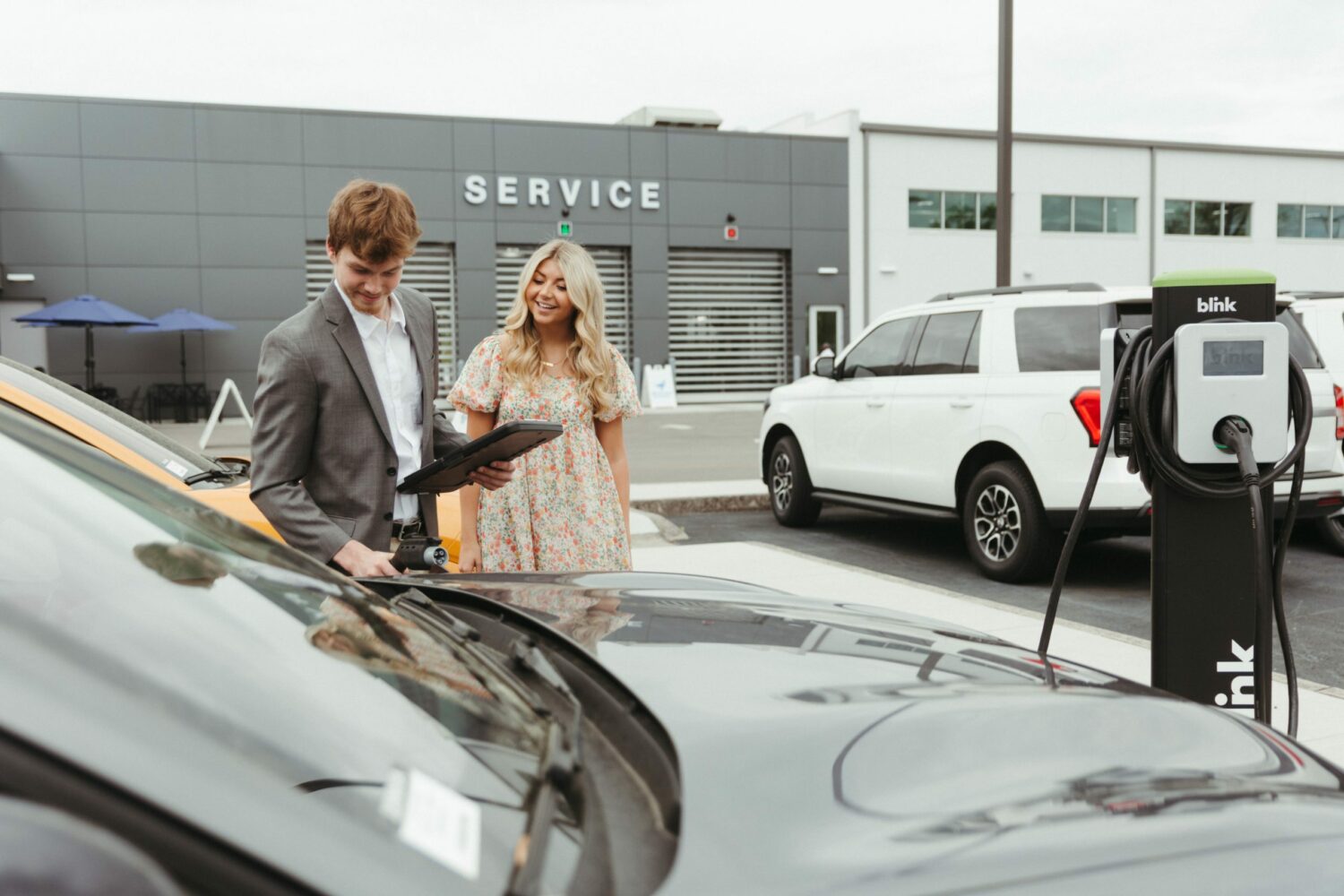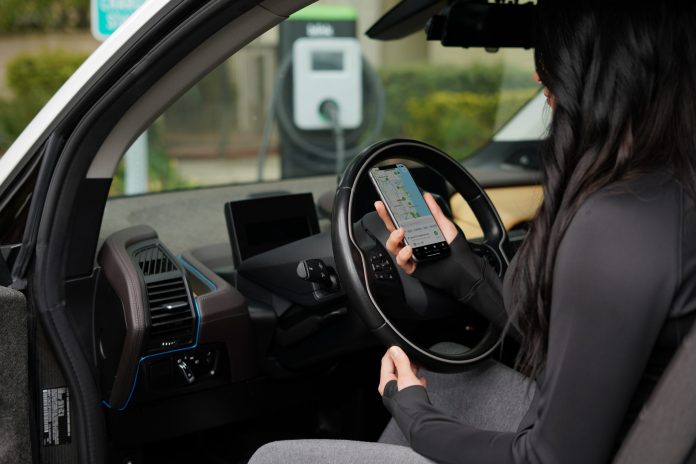It’s a new car-buying season, and many new car buyers want to take advantage of the federal government’s electric vehicle tax incentives. With many customers considering their first EV, it’s up to the dealership sales representatives to answer questions and address knowledge gaps about this new technology. To help, we have compiled some of the most frequently asked questions by dealership customers and new EV owners before buying their first EV.
What is the difference between Level 1, Level 2, and Direct Current Fast Charging (DCFC) stations?
Every electric vehicle has an on-board charger built into the vehicle. Level 1 and Level 2 charging stations supply the vehicle with alternating current (AC) electricity, which the on-board charger converts into direct current (DC) electricity to charge the battery. It’s important to note that the on-board charger is not the same as an external EV charging station, also known as EV Supply Equipment or EVSE. Generally, the term “charger” refers to the charging station or cable that provides power to the vehicle.


Level 1 chargers
Most electric vehicles come with these charging cables that can be plugged into a regular 120-volt connection using any standard household outlet. They are compact enough to carry in a truck and easily plugged into a regular wall outlet. They are primarily designed for slow overnight charging, and it takes more than 12 hours to fully charge an EV from 0% to 100%.
Level 2 chargers
Level 2 chargers are the next step up in charging equipment. Drivers wanting a faster home charging experience can purchase Level 2 chargers, such as the Blink HQ 200, and charge up to 6 times faster than Level 1 charging. In addition, most commercial public, multi-unit, and workplace charging stations will be Level 2 chargers.
Depending on the vehicle, Level 2 charging stations provide up to 80 amps allowing a vehicle to fully charge in 4-8 hours, though some vehicles may take longer. Level 2 chargers can plug into a 240-volt NEMA electrical outlet or be directly wired into a home or building’s existing electrical system. Commercial public chargers will virtually always be hardwired into an electrical system.
As the graphic above shows, AC Level 1 and Level 2 charging stations send AC power to the on-board charger, which then converts to DC power to charge the battery. The spend of Level 2 charging is dependent upon the on-board charger within the vehicle.
DC fast chargers (DCFC)
Unlike Level 1 and Level 2 chargers, DC fast chargers can charge a vehicle in under an hour. That’s because DC fast charging does not need to convert AC power to DC power and can go directly into the vehicle’s battery, bypassing the onboard charger. DC fast chargers provide 100 to 500 amps of power to battery electric vehicles and can charge a vehicle up to 80% in 20-40 minutes.
DC fast chargers require 480-volt power and pull large amounts of electricity in a very short timeframe. Therefore, most DCFC are installed for commercial fleets, near highways, and at other public parking facilities.
How long will it take to charge my EV?
Elements that affect the amount of time it takes to charge a vehicle include:
- The type of charging station (L1, L2, DCFC);
- the size of the vehicle’s battery, and;
- how much power the vehicle’s on-board charger is capable of receiving.
To estimate your vehicle’s charge time, divide your EVs battery size by whichever number is lower, acceptance rate or charger output. This formula will give you the total hours to charge from 0% to just over 80%. It’s important to note that when referring to charging, it is universally accepted to estimate charge times from 0% to 80%. After a vehicle reaches 80% charge the vehicle’s software begins to slow down the battery’s acceptance rate to protect the battery. In fact, according to JD Power, your EV’s battery will last longer if you prevent it from charging 100 % or running it down to zero. To extend your EV battery’s life, remember the 80/20 rule, which means not charging past 80 percent and not letting it drop below 20 percent.
How do I find a charger?
Finding a charger is relatively easy with more chargers concentrated in urban areas. TO find a charger, drivers can use a service such as:
- Google Maps
- Apple Maps
- Their vehicle’s navigation system (if available)
- The Blink app for iOS and the Blink Android app
- The PlugShare website or the PlugShare app for iOS or the PlugShare Android app
Can my Tesla use non-Tesla charging stations?
Yes, Tesla drivers use non-Tesla Combined Charging System (CCS) charging stations with an adapter at Level 2 charging stations. Most Tesla’s even have the adapter standard in the trunk. There is also a DCFC adapter for Tesla vehicles however, it’s size, expense, and widely available Tesla charging network typically discourages widespread use of the DCFC adapter. Many EVSE companies are also bringing to market the Tesla, or North American Charging Standard (NACS) connector in their upcoming products to make EV charging even more accessible.
Can Hybrids use a DCFC?
No, if you have a plug-in hybrid electric vehicle (PHEV) your vehicle typically doesn’t allow for DC fast charging.
To use a DCFC, you must have a matching charging port. While there is a standard plug for Level 1 and Level 2 charging, there are multiple charging standards for DCFC including the CHAdeMO, CCS, and NACS adapters – international plugs have even more options.


How much does it cost to charge an EV?
Now this one is trickier. Many factors make-up the cost of charging your EV. Not only does the size of your battery factor into the equation but so does the owner of the EV charging station.
In most states, you pay per kilowatt when charging your vehicle however, a few states do not allow kilowatt pricing so charging stations charge by duration of the session – in other words, you’re paying for the time you’re connected to the station. In these states, the pricing is establishing to the highest amount of energy that flow through the charger at any given time, even if your vehicle cannot accept energy at that rate. This makes time-based charging more expensive for most EV drivers.
In addition, most EV charging stations are owned by the location that hosts the charger (site hosts). This means that your neighborhood restaurant may choose to establish their own pricing rates. Generally, site hosts base their charging rate on the cost of commercial electricity they are paying for the energy and factor in the cost of installing and owning the equipment.
Pricing can also depend on local utility sourcing, time of day, availability of specialty pricing for certain groups (such as employees or residents), and how many other chargers are located nearby.
For many EV drivers, this inconsistent pricing is frustrating, but drivers can quickly find the best priced charger near them using EV driver applications such as Plugshare.
Conclusion
There are bound to be many questions about EVs for your dealers’ sales team from new-to-EV customers and potential EV buyers. With a little preparedness, your sales team will be able to help these new customers get into the perfect EV to suit their needs. With the Federal EV tax credits now eligible for residents’ 2023 taxes, even those who want to buy a used vehicle can purchase their first EV! Now is the time for dealer team to familiarize themselves with EV terminology and get comfortable answering all the questions bound to come their way. For additional information and training, contact the experts at Blink Charging.



